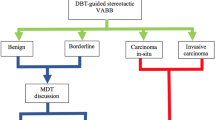Abstract
Purpose
To determine whether the presence of calcifications in specimens collected during stereotactic-guided vacuum-assisted breast biopsies (VABB) is sufficient to ascertain their adequacy for final diagnosis at pathology.
Materials and methods
Digital breast tomosynthesis (DBT)-guided VABBs were performed on 74 patients with calcifications as target. Each biopsy consisted of the collection of 12 samplings with a 9-gauge needle. This technique was integrated with a real-time radiography system (IRRS) which allowed the operator to determine whether calcifications were included in the specimens at the end of each of the 12 tissue collections through the acquisition of a radiograph of every sampling. Calcified and non-calcified specimens were separately sent to pathology and evaluated.
Results
A total of 888 specimens were retrieved, 471 containing calcifications and 417 without.
In 105 (22.2%) samples out of 471 with calcifications cancer was detected, while the remaining 366 (77.7%) were non-cancerous. Out of 417 specimens without calcifications 56 (13.4%) were cancerous, whereas 361 (86.5%) were non-cancerous. Seven hundred and twenty-seven specimens out of all 888 were cancer-free (81.8%, 95%CI 79–84%).
Conclusion
Although there is a statistical significative difference between calcified and non-calcified samples and the detection of cancer (p < 0.001), our study shows that the sole presence of calcifications in the specimens is not sufficient to determine their adequacy for final diagnosis at pathology because non-calcified samples can be cancerous and vice-versa. Ending biopsies when calcifications are first detected through IRRS could lead to false negative results.


Similar content being viewed by others
References
Bonfiglio R, Scimeca M, Urbano N, Bonanno E, Schillaci O (2018) Breast microcalcifications: biological and diagnostic perspectives. Future Oncol 14(30):3097–3099. https://doi.org/10.2217/fon-2018-0624
Tot T, Gere M, Hofmeyer S, Bauer A, Pellas U (2021) The clinical value of detecting microcalcifications on a mammogram. Semin Cancer Biol 72:165–174. https://doi.org/10.1016/j.semcancer.2019.10.024
Depretto C, Borelli A, Liguori A, Presti G, Vingiani A, Cartia F, Ferranti C, Scaperrotta GP (2020) Contrast-enhanced mammography in the evaluation of breast calcifications: preliminary experience. Tumori 106(6):491–496. https://doi.org/10.1177/0300891620919170
Farshid G, Sullivan T, Downey P, Gill PG, Pieterse S (2011) Independent predictors of breast malignancy in screen-detected microcalcifications: biopsy results in 2545 cases. Br J Cancer 105(11):1669–1675. https://doi.org/10.1038/bjc.2011.466
Cheung YC, Chen SC, Ueng SH, Yu CC (2020) ductal carcinoma in situ underestimation of microcalcifications only by stereotactic vacuum-assisted breast biopsy: a new predictor of specimens without microcalcifications. J Clin Med 9(9):2999. https://doi.org/10.3390/jcm9092999
Sickles EA, D’Orsi CJ, Bassett LW et al (2013) ACR BI-RADS® mammography. ACR BI-RADS® atlas, breast imaging reporting and data system, 5th edition
Kettritz U, Morack G, Decker T (2005) Stereotactic vacuum-assisted breast biopsies in 500 women with microcalcifications: radiological and pathological correlations. Eur J Radiol 55(2):270–276. https://doi.org/10.1016/j.ejrad.2004.10.014
den Dekker BM, van Diest PJ, de Waard SN, Verkooijen HM, Pijnappel RM (2019) Stereotactic 9-gauge vacuum-assisted breast biopsy, how many specimens are needed? Eur J Radiol 120:108665. https://doi.org/10.1016/j.ejrad.2019.108665
Chong A, Weinstein SP, McDonald ES, Conant EF (2019) Digital breast tomosynthesis: concepts and clinical practice. Radiology 292(1):1–14. https://doi.org/10.1148/radiol.2019180760
Scaperrotta GP, Boffelli G, Depretto C, Di Leo G, Liguori A, Monaco CG, Borelli A, Ferranti C (2022) Guiding vacuum-assisted biopsy in prone position: digital breast tomosynthesis vs stereotactic. Tumori 108(4):326–330. https://doi.org/10.1177/03008916211016101
Yu YH, Liang C, Yuan XZ (2010) Diagnostic value of vacuum-assisted breast biopsy for breast carcinoma: a meta-analysis and systematic review. Breast Cancer Res Treat 120(2):469–479. https://doi.org/10.1007/s10549-010-0750-1
Park HL, Hong J (2014) Vacuum-assisted breast biopsy for breast cancer. Gland Surg 3(2):120–127. https://doi.org/10.3978/j.issn.2227-684x.2014.02.03
Cheung YC, Chen K, Yu CC, Ueng SH, Li CW, Chen SC (2021) contrast-enhanced mammographic features of in situ and invasive ductal carcinoma manifesting microcalcifications only: help to predict underestimation? Cancers (Basel) 13(17):4371. https://doi.org/10.3390/cancers13174371
Sanderink WBG, Mann RM (2018) Advances in breast intervention: where are we now and where should we be? Clin Radiol 73(8):724–734. https://doi.org/10.1016/j.crad.2017.10.018
Dahlstrom JE, Jain S (2001) Histological correlation of mammographically detected microcalcifications in stereotactic core biopsies. Pathology 33(4):444–448. https://doi.org/10.1080/00313020120083160
Gümüş H, Mills P, Fish D, Gümüş M, Devalia H, Jones SE, Sever AR (2013) Breast microcalcification: diagnostic value of calcified and non-calcified cores on specimen radiographs. Breast J 19(2):156–161. https://doi.org/10.1111/tbj.12069
Hoffmann O, Stamatis GA, Bittner AK, Arnold G, Schnabel R, Krüger K, Kimmig R, Heubner M (2016) B3-lesions of the breast and cancer risk - an analysis of mammography screening patients. Mol Clin Oncol 4(5):705–708. https://doi.org/10.3892/mco.2016.790
Rageth CJ, O'Flynn EAM, Pinker K, Kubik-Huch RA, Mundinger A, Decker T, Tausch C, Dammann F, Baltzer PA, Fallenberg EM, Foschini MP, Dellas S, Knauer M, Malhaire C, Sonnenschein M, Boos A, Morris E, Varga Z (2019) Second International Consensus Conference on lesions of uncertain malignant potential in the breast (B3 lesions). Breast Cancer Res Treat 174(2):279–296. https://doi.org/10.1007/s10549-018-05071-1
Funding
The authors declare that no funds, grants, or other support were received during the preparation of this manuscript.
Author information
Authors and Affiliations
Corresponding author
Ethics declarations
Conflict of interest
The authors have no relevant financial or non-financial interests to disclose.
Ethical approval
This retrospective study was approved by the institutional review board. All procedures performed in the studies involving human participants were in accordance with the ethical standards of the Institution “Fondazione IRCCS Istituto Nazionale dei Tumori” of Milan and with the 1964 Helsinki Declaration and its later amendments.
Informed consent
Informed consent was obtained from all individual participants included in the study.
Additional information
Publisher's Note
Springer Nature remains neutral with regard to jurisdictional claims in published maps and institutional affiliations.
Rights and permissions
Springer Nature or its licensor (e.g. a society or other partner) holds exclusive rights to this article under a publishing agreement with the author(s) or other rightsholder(s); author self-archiving of the accepted manuscript version of this article is solely governed by the terms of such publishing agreement and applicable law.
About this article
Cite this article
Giambersio, E., Depretto, C., Trimboli, R.M. et al. Utility of detection of breast calcifications with integrated real-time radiography system (IRRS) during digital breast tomosynthesis (DBT)-guided vacuum assisted biopsy (VAB): initial single-center experience. Radiol med 128, 699–703 (2023). https://doi.org/10.1007/s11547-023-01636-3
Received:
Accepted:
Published:
Issue Date:
DOI: https://doi.org/10.1007/s11547-023-01636-3




